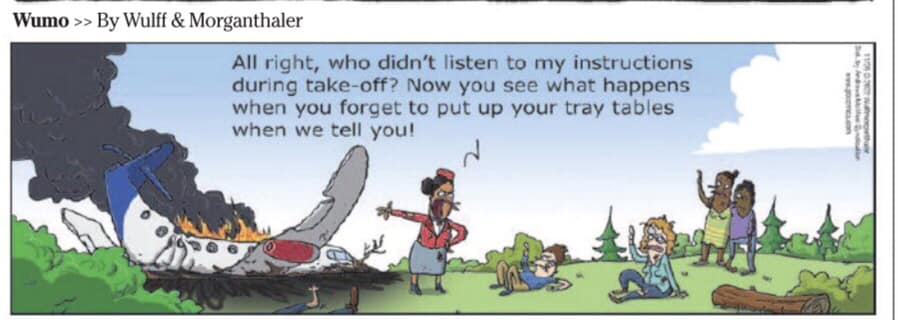If you’ve ever been on a plane, you’ve heard the spiel:
“Ladies and gentlemen, the Captain has turned on the Fasten Seat Belt sign. If you haven’t already done so, please stow your carry-on luggage underneath the seat in front of you or in an overhead bin. Please take your seat and fasten your seat belt. And also make sure your seat back and folding trays are in their full upright position.”
Ever wonder why you have to do all of that when you’re taking off and landing?
It’s all in the interest of safety.

No, not THAT kind safety 😉
Y’see, Boeing has been publishing statistical studies since 1969, and according to their research, ever since the jet age started in 1959, 10% of aviation fatalities happen during taxi, load/unload, park and tow, 12% happen during takeoff and the initial climb and 49% occur during the final approach and landing.
Since preparation for evacuation would most likely be necessary if a plane is having problems, airlines want to ensure that aisles and access to aisles are as clear as possible so passengers can get to whichever area they’re going to evacuate from. Tray tables being down will get in the way, as would any unstowed baggage on the floor (which could also become projectiles, depending on the type of emergency). Seats in the reclined position will also make the space for people getting out of their seating area that much smaller.
Having the tray table up during take-off and landing is considered so important that it’s included as an FAA regulation (boldface for emphasis):
§ 121.577 – Stowage of food, beverage, and passenger service equipment during airplane movement on the surface, takeoff, and landing.
(a) No certificate holder may move an airplane on the surface, take off, or land when any food, beverage, or tableware furnished by the certificate holder is located at any passenger seat.
(b) No certificate holder may move an airplane on the surface, take off, or land unless each food and beverage tray and seat back tray table is secured in its stowed position.
(c) No certificate holder may permit an airplane to move on the surface, take off, or land unless each passenger serving cart is secured in its stowed position.
(d) No certificate holder may permit an airplane to move on the surface, take off, or land unless each movie screen that extends into an aisle is stowed.
(e) Each passenger shall comply with instructions given by a crewmember with regard to compliance with this section.
And that’s why you have to stow away your tray table during takeoff and landing.
Feature Photo: Delta Air Lines
Want to comment on this post? Great! Read this first to help ensure it gets approved.
Want to sponsor a post, write something for Your Mileage May Vary, or put ads on our site? Click here for more info.
Like this post? Please share it! We have plenty more just like it and would love it if you decided to hang around and sign up to get emailed notifications of when we post.
Whether you’ve read our articles before or this is the first time you’re stopping by, we’re really glad you’re here and hope you come back to visit again!
This post first appeared on Your Mileage May Vary
